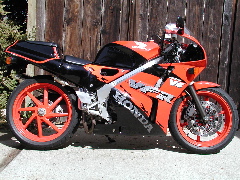April 23, 2003
 |
|
|
|
G-Force Custom Piston and Wrist Pin
|
|
|
|
|
For many months I've been talking about the 450cc kit that
G-Force was making for my NC30 race bike. Over the last month, the parts started coming in and they have turned out better than I expected. Here are some pictures of the custom 450cc piston and the titanium rods that were made, shown in comparison to the original NC30 parts (see pictures below). Unfortunately I don't have an NC35 piston to compare to, but the stock rod is the same between the two models. The new piston and rod shown are designed to work in both the Honda NC30 (VFR400) and NC35 (RVF400).
This all started when I bought my first NC30 last year. The bike came with a 400cc engine installed, and with a spare 444cc engine built using the 444cc piston kit from JE. That engine's crank had spun a bearing long before I got the bike and was replaced with the 400cc engine I'm using today. I let Mike Norman at G-Force look the engine over to understand the cause of the failure and that got the design ideas flowing.
 |
|
|
|
G-Force Titanium Rod
|
|
|
|
|
Looking at the pictures below, and comparing the weight of the pistons, I'm not surprised the 444 engine spun a bearing. The JE piston is about 18 grams heavier than stock (piston and wrist pin), and at 14K RPM, that's enough to blow a crank bearing. The G-Force piston is about 7 grams less than stock (piston and pin), but it is stronger than stock. It seems that the G-Force piston should weigh less, but consider it is designed to be strong, like the JE piston was, but smaller and with less friction (like a Formula I piston). Also, notice below that the JE piston has only one compression ring and an oil ring. Most pistons use two compression rings and an oil ring. I assume JE did this to reduce friction. G-Force decided to reduce friction at the skirt and use two compression rings like normal. In the 444 motor, we saw that with only one compression ring, there was a lot more blowby on the JE piston, so friction is reduced, but at the expense of allowing more blowby and reduced efficiency or longevity. The G-Force piston and rod were designed for longevity. I said from the beginning, this engine needs to last. Endurance is more important than power gains for me, especially since I do endurance racing on my VFR as well. I can't afford to rebuild this engine every season.
The titanium rods look more bulky than stock, but they are actually 40 grams less than stock. Most of that weight is in the bolts at the big end of the rod. Tossing the two rods around, you can only slightly feel the weight difference, but if you remove the bolts on both rods, the difference is astonishing. Furthermore, if you hold the big end (with the bolts installed) and flop the little end back and forth, you really notice the difference as well. This is important because the big end of the rod always makes gradual circular movements (following the crank - a relatively low acceleration of mass), but the little end makes violent side to side and up and down movements with each stroke (with acceleration figures in the tens of thousands of feet per second). So, the weight is missing where it needs to be missing the most. This weight, coupled with the reduced piston weight, should make for a more reliable engine, even at higher higher RPMs.
Other details not shown here are how you bore out the cylinders and treat the crank (two important factors in making a reliable engine). We believe the other possible reason for the crank failure on the 444 engine might have been how the bore was made (a mistake at the machine shop). G-Force has a different method of doing this, which should alleviate this issue. Alas, the engine isn't complete yet. We are still waiting on the crank to be finished. But, I expect to be using this engine within a month.

Available pistons for the NC30/35 with wrist pins. From left to right: my new 450cc piston from G-Force, stock NC30 piston, JE 444cc kit piston. |

Same arrangement, showing skirt view. Notice difference in piston pin length as well as the reduced skirt area on the G-Force piston. Also, note JE's single compression ring. |

Top and skirt view.
|

Top view. The stock piston is forged and machined. The G-Force and JE pistons are machined from a solid piece of aluminum. |

Underside. This shows part of why the JE piston is the heaviest piston. Note the amount of material for holding the rod. This was over designed. |

The G-Force 450cc piston and pin.
|

A stock NC30 piston and pin.
|

The JE 444cc kit piston and pin.
|

Comparing rods. Left: The G-Force titanium rod. Right: a stock NC30 rod. The G-Force rod looks bigger, but it is 40 grams less than the stock steel rod. Most the TI rod's weight is in the bolts, meaning the upper end of the rod is significantly lighter than stock. |

The G-Force titanium rod. |

A stock NC30 rod. |



